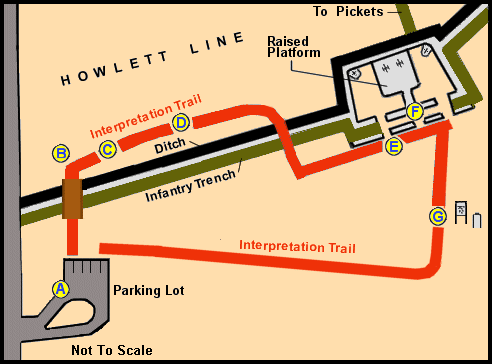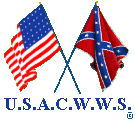
|
U. S. CIVIL WAR
PHOTOGRAPHS
|

|
PARKER'S BATTERY
(Page 1 of 3)
In the text, the icon  is a link to the definition of the word it marks.
is a link to the definition of the word it marks.
Use your
browser's "back" button to return to the page.
| |
This small Confederate artillery work helped to immobilize Union
Gen. Benjamin F. Butler's Army of the James during its attack on Richmond in May,
1864. Fighting, which continued into June, successfully "bottled up" Butler at
Bermuda Hundred. The battery work helped to immobilize Union
Gen. Benjamin F. Butler's Army of the James during its attack on Richmond in May,
1864. Fighting, which continued into June, successfully "bottled up" Butler at
Bermuda Hundred. The battery then became part
of the Howlett Line helping to defend Richmond until the capital was abandoned
in April 1865. then became part
of the Howlett Line helping to defend Richmond until the capital was abandoned
in April 1865.
(Text Source: U.S. Gov't, National Park Service)

Map of Parker's Battery (Including the N.P.S. Interpretation
Trail and the Location of the Photographs in this section.)
The photograph locations are marked by letters which are referred
to in the text.(Click on a letter to view a representative photograph)

Entrance to Parker's Battery. (A)
The arrow marks the Park Service Sign. To the left of the sign, a just-visible
wooden bridge begins the Park trail.

Parker's Battery Entrance Sign. (A)
This sign displays the Richmond National Battlefield Park Map (see
reference),
and a map of Parker's Battery, with a brief description.

A more descriptive sign on the Interepretation trail. (B)
Some of the text:
This site seems remote from Richmond but Confederate defenders extended
well beyond the city. From mid-June 1864 a unit of artillerymen called
Parker's Battery manned these earthworks.
Despite the proximity of a large enemy force, this line was quiet for the
next 9 1/2 months---just an occasional shelling, or pickets taking potshots. The shooting war
was a few miles northeast and south. taking potshots. The shooting war
was a few miles northeast and south.
After the fall of Petersburg, Parker's Battery retreated with Lee to
Appomattox.
Although it became known as "The Boy Company" the average age was
twenty-five.
|
|

Parker's Battery Interepretation Trail (C)
|
|
PAGE TWO
 >
Civil War Photos
>
Richmond - Outlying Area
> Parker's Battery
>
Page 2
>
3
>
Civil War Photos
>
Richmond - Outlying Area
> Parker's Battery
>
Page 2
>
3



